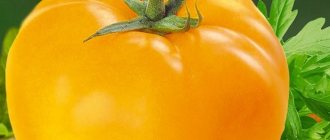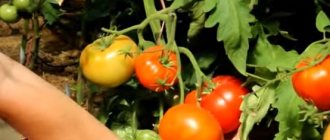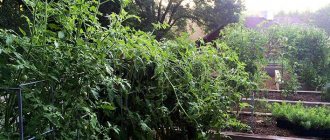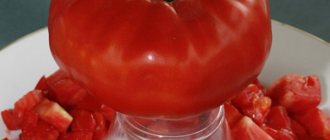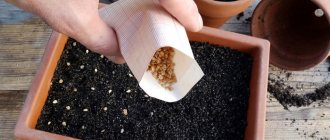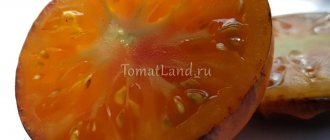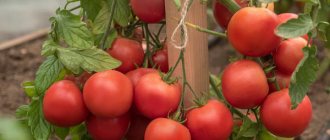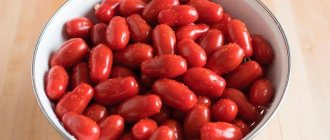Characteristics of the variety
Chanterelle belongs to the low-growing, so-called determinate varieties. The growth of the bushes ends after the fourth or fifth brush appears on it. When grown in open ground, the height of the bushes does not exceed 60 centimeters, and in greenhouses it can reach 110 cm. The bush is characterized by a thin stem and medium-sized rich green leaves. The structure is spreading. The chanterelle tomato cluster is simple, the flowers are small yellow, and one cluster bears 4 to 6 fruits. The manufacturer indicates that the variety belongs to the category of mid-early, with a long fruiting period. Harvest can be done as early as mid-July.
Reviews from gardeners
Polina Medvedeva, Volgograd
My Chanterelle tomatoes are one of those “must be planted” tomatoes. I’ll explain why: in rainy, cold summers they simply save me, and in general, in any weather they can withstand both heat and cold dampness. The harvest is always plentiful and the taste is excellent. You just need to wait until they are fully ripe for the tomatoes to be tasty and sweet - they should have a deep orange color. Well, you can put slightly unripe ones in a jar. They are some of the most beloved ones when preserved: they have an unusual color and shape, they are tasty, they are always intact, and the skin does not crack. I rarely use it for juice (only to collect seeds), more often with other varieties so that the color is beautiful.
Natalia Korovaeva, Kamensk-Shakhtinsky
A friend gave Chanterelle tomatoes as seedlings and highly praised them. Indeed, I was also satisfied. I didn’t notice any difficulties in caring for it; I had to tie it up. But I’m so used to it, I tie up all the tomatoes so that they don’t get dirty. They watered when there was time, often even only on weekends, but the harvest was pleasing, so they closed it and ate it. Tomatoes are dense, good to take with you on the road. We will plant more.
Tomato Chanterelle: fruit characteristics
Tomatoes of this variety are glossy and smooth, they have a thin but quite durable skin that does not crack. The shape of the fruit is plum-shaped, elongated-oval. In the cross section you can see that the tomato has two or three chambers with an average number of seeds. Ripe tomatoes of this variety have a bright orange color, however, as gardeners say, there are red and yellow tomatoes. The taste of tomatoes is sweet, the flesh is dense. The length of one tomato is 4-5 centimeters, weight is about 100-130 grams.
Tomatoes of the Chanterelle variety are characterized by an increased content of various microelements and vitamins. Due to the fact that the variety's low calorie content is combined with the presence of vitamins A, B, C and E, as well as components such as beta-carotene and magnesium, the vegetable is suitable for a healthy diet. Summer residents note: Chanterelle can be eaten fresh, for example, as part of side dishes and salads, and it can also be canned. Tomatoes are stored well and can withstand transportation without losing their excellent presentation.
Harvesting and application
Chanterelle tomatoes begin to ripen approximately 100 days after the sprouts appear. Fruiting is extended and continues until the end of August. The fruits of the variety are universally used, good both fresh and for storing for the winter. A positive feature of Chanterelles is that small, fleshy tomatoes are suitable for drying in the sun or in the oven.
Gardeners note that at the stage of technical ripeness (yellow), the fruits do not have a pronounced tomato taste and aroma. It is advisable to wait until the tomatoes are fully ripe, when they turn orange, to fully enjoy their taste.
Productivity and fruiting time
The productivity of Chanterelle tomatoes, declared by the manufacturer, is 9 kilograms per square meter. Moreover, the indicator practically does not depend on whether vegetables are grown in a greenhouse or in open ground. No more than 3-4 bushes can be planted on one square meter. From the moment the seedlings appear until the first harvest is harvested, no more than 100-110 days usually pass. That is, seeds sown for seedlings in the third ten days of March will allow you to taste the first fruits in the second half of July. Fruiting continues until the end of summer.
In order to get the maximum number of ripe tomatoes from one bush, experienced gardeners recommend doing the following:
- carefully select healthy planting material and process it before sowing;
- It is best to form a bush not in 1, but in 2 or even 3 stems;
- the Chanterelle tomato needs regular tying up and removal of shoots;
- It would not be superfluous to fertilize with fertilizers - both organic and mineral;
- Among the necessary procedures are watering, mulching, loosening and weed removal.
Advantages and disadvantages, reviews and recommendations from agronomists
The tomato pleases with its yield and decorative appearance. In addition, it has other enviable qualities:
- Composition rich in vitamins. The carrot color of Chanterelle tomatoes indicates the presence of beta-carotene. At the same time, tomatoes are considered dietary and can be consumed with forced calorie restriction. Chanterelle is hypoallergenic and therefore suitable for baby food.
- The Chanterelle tomato tolerates frost (when grown in greenhouses) and is not afraid of changes.
- The harvest is transportable, the skin does not burst, and dents do not form.
- Long-term storage of the harvested crop is possible.
- The taste is rich, the tomato is suitable for salads, you can fill jars with whole fruits.
Flaws:
- Thin stems need support.
- Frequent stepsoning.
- Tendency to late blight.
Reviews:
- The branches are like a cobweb - thin and numerous. You have to tie it up often and keep an eye on the tassels. But this is compensated by a juicy and strong harvest. The skin is thin, but does not burst (Ksenia, Vsevolozhsk).
- Grown into 4 stems. They ripen together, the taste is bright. The variety lasted the longest, did not freeze or get sick (Anna, Petrozavodsk).
Resistance to diseases and climatic conditions
Gardeners call the main difference between Chanterelle and other varieties its amazing resistance to unfavorable climatic conditions. Neither temperature changes, nor heat and drought or cold snaps will have a detrimental effect even on young seedlings. It should also be noted that there is high immunity to various diseases to which nightshade crops are usually exposed. Tomato Chanterelle, according to reviews, is not afraid of even late blight! True, preventive measures should not be abandoned. To do this, it is recommended to adhere to the following rules:
- When planting, it is necessary to leave at least 30 centimeters between the bushes;
- promptly remove lower and yellowed leaves;
- the pinching procedure will have a positive effect on the growth and resistance of the disease plant;
- Plants can only be watered at the roots; water should not get on the leaves and ovaries;
- the soil in the greenhouse should not be too wet, like the air;
- plants affected by late blight must be destroyed immediately - experienced gardeners recommend burning the bushes
Pros and cons of the variety
In reviews of the Chanterelle tomato (in the photo you can see the fruits in cross-section), gardeners note: its resistance allows you to grow plants not only in the middle zone, but even in the northern regions of the country. Both in the open ground and in the greenhouse, equally high yields are observed. The advantages include a long period of fruiting and the unpretentiousness of the plant. In addition, the appearance and taste of tomatoes are excellent, they are distinguished by their universal use. True, it was not without its drawbacks: the Chanterelle requires timely stepsoning and tying up. Without this, the fruits will be smaller and the bushes may break off under the weight of the tomatoes.
New products from agro
This agritech firm was founded in 1994. It operates in the seed sales market for professionals and amateurs in all regions from the Urals to the Far East. not only sells seeds of vegetable and flower crops of domestic and foreign selection, but also has its own experimental and demonstration fields. This makes it possible to evaluate seeds in a sharply continental climate. This season the company offers 4 new products.
Casper
This early variety is distinguished by such characteristics as bush compactness, excellent setting, attractive appearance of elongated oval fruits (average weight 95-100 g) and high yield.
Novosibirsk red tomato
Novosibirsk pink tomato
These early varieties have similar characteristics, they differ only in the color of the fruit. The first inflorescence is laid above the 8th leaf, and the subsequent ones - after 1-2 leaves. Among the advantages of these varieties, it is worth noting the compactness of the bush, high yield, excellent fruit set, and their original cube-shaped shape. At the same time, the tomatoes are very dense, weighing from 90 to 110 g.
Kira F1
This early ripening hybrid is recommended for growing in protected ground. Unlike the previous ones, this plant is indeterminate (more than 2 m in height). The fruits are dense, red, elliptical in shape, weighing 25-30 g, very tasty.
Agrofirma MARS LLC has been operating in the seed market since 1998 and sells high-quality products under the name “Ural Summer Resident”. Varieties and hybrids are tested in the unstable climate of the Urals, so even in unfavorable summers, the grown crops give a good harvest.
Specialists from the Chelyabinsk Breeding Station have produced new tomato hybrids without the use of GMOs. All of them are resistant to the main diseases of tomatoes, lack of light, as well as the main problem of the Urals and Siberia - June return frosts.
Red red F1
A unique early ripening hybrid of the carpal type, intended for cultivation in closed ground. The plants are tall, medium-branched, form one stem at a planting density of 3 plants per 1 sq.m. Each cluster ripens 5-7 fruits weighing 200-500 g. They are red, round, smooth, dense, with sugar pulp. From one bush you can harvest up to 8.5 kg of tomatoes.
Maryina Roshcha F1
Early maturing indeterminate hybrid. A powerful bush is formed into one stem at a planting density of 2.5 plants per 1 sq.m. The plant is famous for its unbridled productivity. 7-9 fruits of 150-170 g each ripen on the clusters. They are round in shape, red in color, hang from the bushes in bright cascades and ripen very quickly. The plant is resistant to temperature stress, tobacco mosaic virus (TMV), fusarium, and cladosporiosis. Productivity – up to 17 kg of tomatoes per 1 sq.m.
Tretyakovsky F1
Medium-early tall hybrid with tasty fruits. The clusters are compact, with 7-9 fruits, 120 g each. Ripe tomatoes have a rich crimson color and a unique taste; when cut, their juicy flesh shines beautifully. This tomato is called medicinal because it contains a lot of lycopene, carotene and selenium.
Red Guard F1
Thanks to the ultra-earliness and abundant fruiting of this hybrid, you can enjoy the first delicious tomatoes at the end of June. The tomato is tolerant to low light, fruit cracking, cold-resistant, and does not require pinching. The plant is formed into 1-3 stems. The planting density is 2.5 plants per 1 sq.
Growing seedlings
The optimal time for sowing seeds is the third ten days of March. Calculate the time taking into account the fact that after about two months the seedlings will need to be transplanted into a greenhouse or garden bed. The ideal soil is light soil, which includes peat, garden soil and sand. In order to disinfect the soil, you can calcine it in the oven at a temperature not exceeding 100 degrees, or simply pour boiling water over it. Gardeners note: both common boxes and individual cups or peat pots are suitable for forcing seedlings. In the latter case, it will be possible to do without picking. The first thing you need to do is process the planting material. An aqueous solution of hydrogen peroxide or a slightly pink solution of potassium permanganate is suitable for this purpose. After this, the seeds will need to be immersed in a growth stimulator.
Tomato seeds should be buried just a centimeter, then the soil needs to be moistened - either by drip method or using a spray bottle. Containers should be covered with film or glass and left in a well-lit place. Usually, before the first shoots appear, the soil does not need watering. After the second true leaf of Chanterelle tomatoes appears (in the photo above you can see seedlings of this variety), the seedlings should be pruned. Due to the fact that the plant is resistant to temperature changes, you can do without the hardening procedure and immediately transplant the seedlings to a permanent place.
Features of planting and growing in open ground
Growing in open ground involves obtaining seedlings in a greenhouse or greenhouse. Despite all its unpretentiousness and frost resistance, it is still a tomato, so it has its own requirements for growth conditions.
Important! Seeds are planted 55–60 days before transplanting young bushes into open ground.
Like any other tomato, Chanterelle prefers to grow in moderate humidity and maximum warmth. If such conditions cannot be achieved, you need to reduce watering to a minimum and help the plants get maximum heat and light.
Before planting, the seeds must be treated, preparing them for the difficult conditions of germination and further growth:
- visual inspection of seed material and rejection of empty grains;
- disinfection in a solution of potassium permanganate - 15–20 minutes;
- soaking in filtered neutral water for 2–3 days until the sprouts hatch.
After this, the seeds are planted in plastic or peat cups with soil for vegetables, 2-3 pieces each. If the soil is not purchased and has not been prepared in advance, it should be spilled with a light solution of potassium permanganate.
Transfer
Chanterelle tomato seedlings should be planted in a garden bed or greenhouse in late spring or early summer, when consistently warm nights have established themselves. A small amount of compost and mineral fertilizers should be added to the prepared holes, then they should be watered with water and only after that the seedlings should be planted. If individual peat pots were used when diving, you can place the plants in the hole directly in them. It is recommended to tie up small bushes immediately. More than 4 plants should not be planted on one square meter. The optimal scheme is 30 x 40 or 40 x 40 cm.
Tomato care
Almost all varieties of tomatoes need a lot of moisture. That is why the soil in the greenhouse or garden bed should not be allowed to dry out. Watering should be done regularly, using only warm water. Try to ensure that moisture does not get on the leaves and that the soil in the greenhouse does not become waterlogged. From time to time, bushes need to be treated with antifungal drugs. Loosening, weeding and mulching will be needed as necessary. For the latter, leaves, sawdust and mowed grass are suitable. A month after you plant the Chanterelle in a permanent place, the lower leaves need to be removed. To keep the fruits large and juicy, 7 clusters should be left on the stems. It is recommended to feed the plants three to four times: mineral complexes or organic fertilizers are suitable. It is extremely important to apply them during the period of flowering and fruit formation.
Agricultural technology for tomato cultivation
The one who planted the Chanterelle tomato claims that it is better to sow seeds for seedlings 55-65 days before the expected date of planting in a permanent place. The procedure involves preparing the soil and treating the seeds with an aqueous solution of hydrogen peroxide. To improve plant immunity, seeds are additionally soaked in a preparation that stimulates crop growth.
The seeds are placed in containers filled with substrate to a depth of 1 cm. After this, they are watered with warm water in a dropwise manner, evenly spraying the moisture, and covered with film until sprouts appear.
Before planting, add compost and complex mineral fertilizer to the holes, water and plant the bushes. Caring for plants involves regularly hilling the bushes to form additional roots.
During the growing season, it is recommended to fertilize with mineral and organic fertilizers. At each stage of plant development, it is necessary to carefully monitor the composition of mineral nutrition for the crop.
This will ensure the normal formation of the bush, the formation of ovaries, and the ripening of fruits. The Chanterelle variety requires the removal of excess shoots in order to increase the yield from the bush. 30 days after planting the plants in the ground, you need to remove the lower leaves.
During the entire period, it is important to follow the crop watering regime. To maintain a constant level of humidity and prevent the top layer of soil from drying out, mulching is carried out
Special black fiber or organic materials (hay, straw, leaves) are used as mulch.
The Chanterelle tomato is included in the State Register of Breeding Achievements. The variety is intended for cultivation in open and protected ground. Tomatoes are distinguished by their taste and versatility in cooking.
Advantages of the variety
The plant belongs to the determinant type; during the growing season the bush reaches a height of 90-110 cm. Bushes with thin stems, large leaves, green in color. The variety is characterized by the formation of a simple inflorescence, a stalk with an articulation.
The shape of the fruit is oval, elongated, and resembles an egg in appearance. An unripe tomato is light green in color; at the stage of technical ripeness it acquires an intense orange color.
Tomatoes have a glossy surface, thin skin that is not prone to cracking. The pulp of the fruit is thick, medium density with a rich sweet taste. With a horizontal cut, 2-3 chambers with seeds are observed.
Tomato contains a large amount of vitamins and microelements. The Chanterelle variety is rich in magnesium. The fruits are low-calorie, which allows the product to be included in the diet.
The fruit weight reaches 110-130 g. The crop yield is 9.1 kg per 1 m². The one who grew the Chanterelle variety claims that you can increase the yield from the bush by forming the plant into 3 stems. To prevent damage and deformation, the bushes are tied to additional support.
Reviews from vegetable growers indicate the possibility of universal use of fruits. In cooking, tomatoes are used for canning whole fruits and preparing salads. Dishes with Chanterelle tomatoes have a rich tomato taste.
